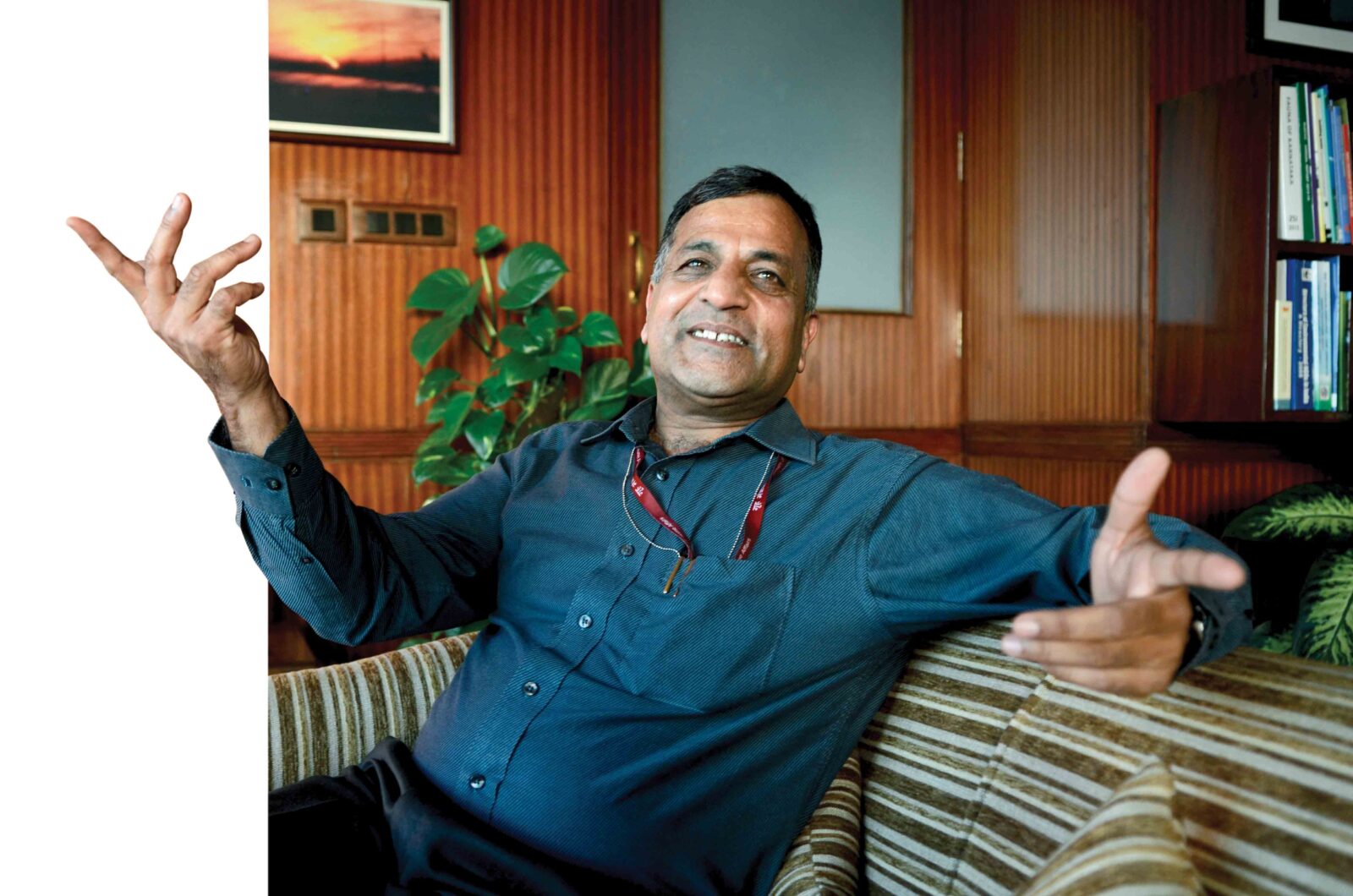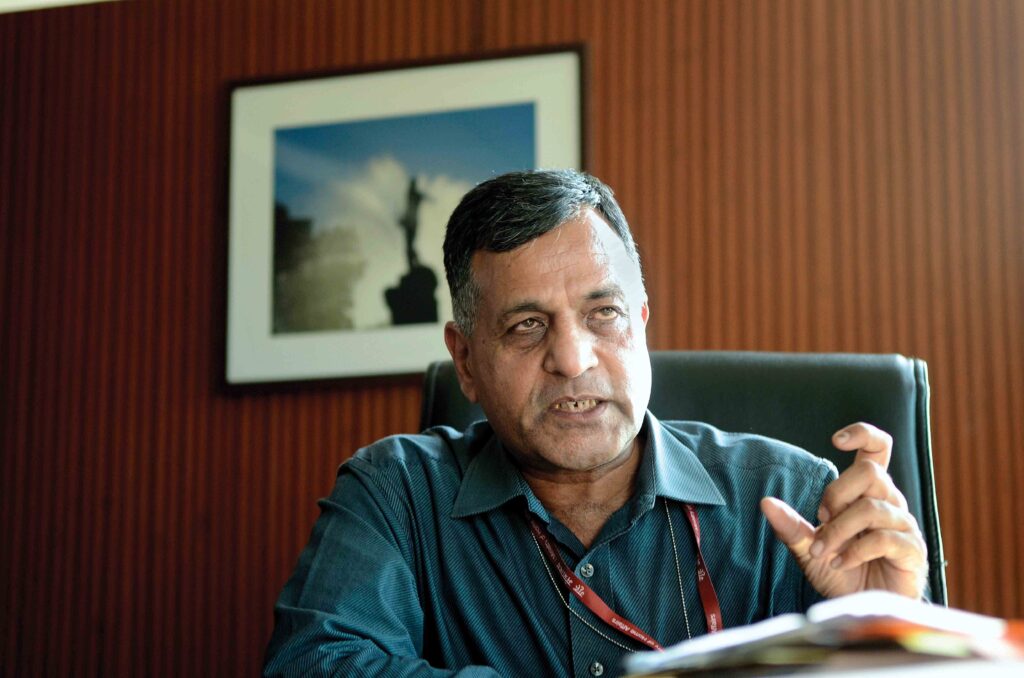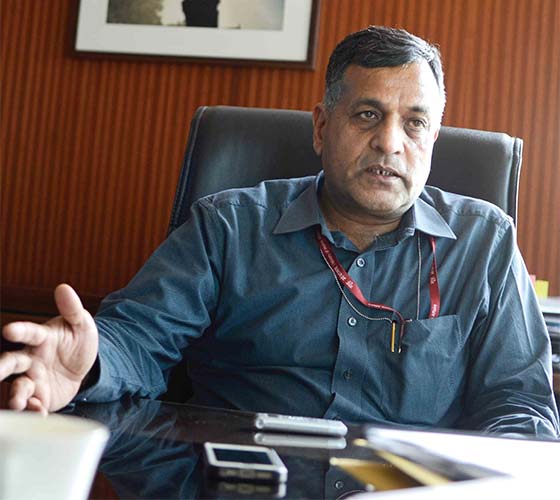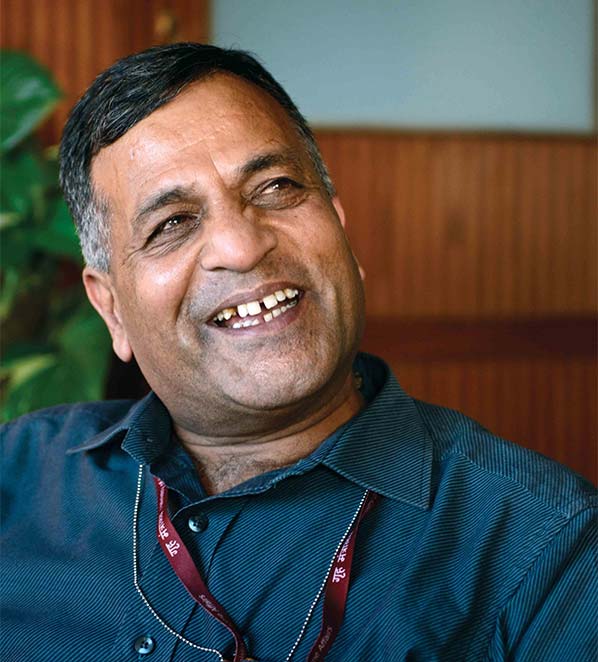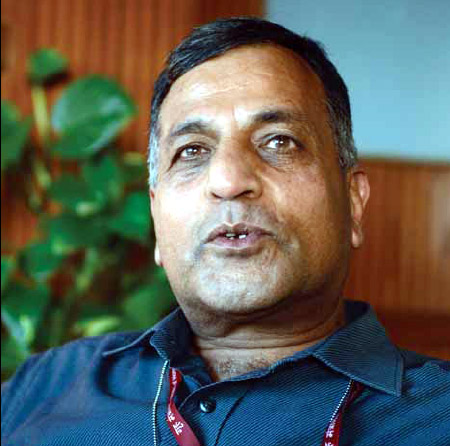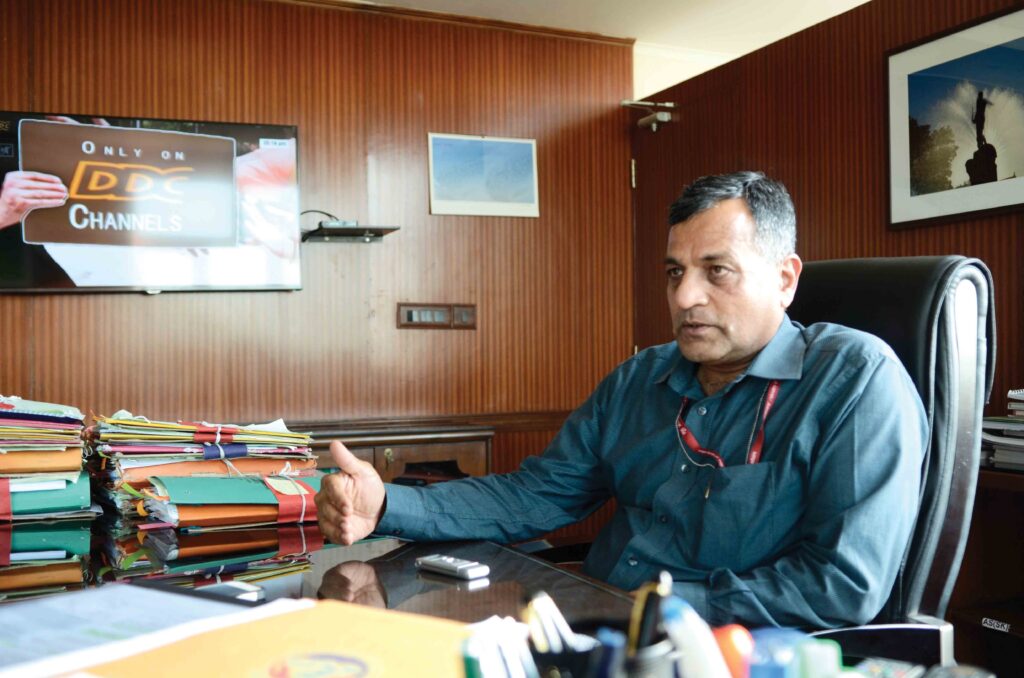- Cover Story
- Governance
- Globe Scan
- Corruption
- State Scan
- Talk Time
- Cover Story
- Governance
- Globe Scan
- Corruption
- State Scan
- Talk Time
Recent Posts
© Copyright 2007 - 2023 Gfiles India. All rights reserved powered by Creative Web INC.Big Boss‘Environment is not only about project clearances’
Ashok Lavasa, a 1980-batch IAS officer of the Haryana cadre, is an MPhil in defence studies, also holds an MBA and is currently Secretary, Ministry of Environment, Forests and Climate Change. He has immense administrative experience in the Ministries of Civil Aviation, Power, Home Affairs, and the Department of Economic Affairs in the central government and in Haryana where he began as SDO, Mahendragarh, and has served as Principal Secretary, Department of Power, and Chairman, Haryana Power Generation Corporation. He is an ace photographer and uses his photographs for New Year greeting cards and calendars. He swims, plays tennis and cricket and is an ardent trekker. He has trekked to almost every nook and corner of the Himalaya. A fan of yesteryear singer KL Saigal, he is innovative and, apart from administration, has worked in areas that require a great degree of research and analysis of experience as well as collation of evidence. Lavasa has also authored An Uncivil Servant, published by Rupa. He spoke to gfiles Editor Anil Tyagi on issues of environment, forests and climate change in India.
Anil TyagiApril 4, 201520 Mins read188 Views
 Written by Anil Tyagi
Written by Anil TyagiThere is a debate going on that this government is giving short shrift to environmental concerns while sanctioning different projects that had been blocked by the UPA regime. It seems you are determined to welcome everybody, keeping environmental issues aside…
There are various norms prescribed under the Environment Protection Act, the Indian Forest Act and the Forest Conservation Act. Therefore, the industries and projects being set up are required to take certain mitigation measures to ensure that they comply with all the regulations for environment protection. So, there is a regime under which they come and seek approvals of the Ministry of Environment, Forests and Climate Change (MoEFCC) for forest clearance, wildlife clearance, coastal zone regulation clearance and environment clearance.Unfortunately, for the past several years, this side of the functioning of the Ministry has been given undue exposure. The MoEFCC is also doing a lot of work in other fields of environment, for example, biodiversity, climate change, the tiger conservation project, the elephant conservation scheme and many schemes being implemented for the protection of biodiversity and the fauna and flora of the country and carrying out many research and development activities, environment education and awareness-building programmes. So, to my mind, those constitute an integral part of the functioning of the MoEFCC.
But, as I said, in the last few years the functioning of the ministry regarding sanctioning of projects has received a lot of attention. According to my understanding, this has happened because of the time taken by the ministry in the past to approve these projects, or to decline. What we have been attempting to do is that without diluting any regulations, or without compromising with any legal requirement, we make the procedure transparent so that it reduces discussion and minimises the scope of arbitrary decision making. Our effort is to make the procedures a little simpler and straightforward, so that there is not a very complicated mechanism by which people have to fulfil their requirements. The idea is that, through these transparent procedures, we create a predictable environment so that a person knows if he takes all the steps, he can hope to get a clearance, or he is told very clearly that this is the case in which you will not get any clearance.
It is said that we are the most polluted country in the world. Don’t you think we are lagging much behind, as far as environment is concerned, in the world?
Well, I don’t know what is the yardstick by which one reaches the conclusion that India is the most polluted country in the world. I have certainly not come across any global index where India can be categorised as the most polluted. Having said that, nobody can undermine the importance of giving due attention to all measures required to protect the environment. For example, India is a land of rich biodiversity; a land in which the forest cover at present is only 23-24 per cent, which includes the tree cover outside forest areas. We want to increase it to 33 per cent as far as the National Forest Policy is concerned. So this will require a major effort to bring more and more areas under afforestation programmes.But it seems we are going on an acquisition spree—acquiring forest land for industrialisation and for big cities?
You are talking about utilisation of forest land for non-forest purposes. See, if coal deposits and various other minerals of the country are found in areas which are also a forest, then, as a nation, a decision has to be taken whether we can live without utilising those minerals, or can we, through a rational process and a process of scientific mining, minimise the damage to the forest and exploit those minerals for the economic well-being of the country. It is for this reason that the scheme of compensatory afforestation was started. Under this scheme, if you are diverting, let’s say, 100 hectares of forest land for non-forest purposes, you have to do plantation in an equivalent area of land.But this is not being done! The MoEFCC in 2005 stated that land acquisition of 100 hectares or more needed permission. But that is being stopped and under pressure of builder lobby, it is not being implemented!
No, it is. I am talking about this policy wherein if anybody wants to divert forest land for non-forest purpose, then he cannot get a forest clearance unless he purchases an equivalent amount of non-forest land and transfers that land to the forest department for growing green cover. That is one part. The second part is that he also has to deposit the cost of carrying out the compensatory afforestation. So, the money required to plant trees on that land and to maintain that land till the trees grow, has to be deposited by the project proponent.In addition, there is a concept of net present value (NPV) of the forest cover, which is lost because the belief is that when you remove a forest, you also remove biodiversity from that area which is very difficult to compensate. It is because of this that the concept of NPV was introduced. There is a formula by which the NPV lost is calculated and the project proponent is expected to deposit that NPV also in the kitty.
Just to give you an idea, so far about Rs. 38,000 crore has been deposited under this compensatory afforestation scheme. This amount is lying in a deposit and the scheme is currently being operated under the supervision of the Supreme Court. It is the effort of the government to obtain the necessary permission of the Supreme Court so that 90 per cent of the amount is transferred to the states to undertake compensatory afforestation. This, according to us, will go a long way in increasing the green cover in the states.
In the last few years the functioning of the ministry regarding sanctioning of projects has received a lot of attention. According to my understanding, this has happened because of the time which has been taken by the ministry in the past to approve or reject these projects
Let us talk about urbanisation. Nearly 27 per cent Indians live in urban areas and we have 3,245 towns and cities. But only 21 towns have sewerage and other amenities. We are today focusing on the development of big cities, acquiring land and giving permissions, rather than improving the municipal conditions of the existing towns. Why this contradiction?
The ways in which urbanisation takes place and drivers of urban growth operate are multifarious. Why is it that people come towards big cities? Why is infrastructure developed in these big cities? There are various factors which are being taken into account. I think the challenge of urbanisation is whether we can provide adequate infrastructure, clean water, clean air, electricity and basic amenities required for decent living. Also, I think, in times to come, a big challenge will be to ensure energy-efficient growth. Can we do that? Because, if you go by some reports on the future urban growth of India, about 70 per cent of the buildings in towns are yet to be constructed. So, if we are looking at such major construction in urban areas, then we have to make sure that these buildings are constructed in an energy-efficient way—they use energy to optimum capacity, use materials which are environment-friendly, comply with the energy-efficiency building code and energy conservation building code.
But why the focus on new towns and new cities, as the existing cities are deprived of these energy-efficient facilities? Why are we not able to provide these facilities to these cities?
Let’s take the example of providing water supply to urban areas. How to do that is under the concerned state. Thus, the MoEFCC is propagating and requesting the state governments and their ministries of urban development to promote dual piping system in urban areas. We should focus a lot on recycling water. We have already asked the industries to move towards zero-liquid discharge. It means that those industries discharging their effluents in public sewers should actually recycle the water and use it for their industrial use; what cannot be used can be shared with other industries; and what cannot be shared with other industries can be used for greening their internal premises. So, if you move towards the zero liquid discharge, then you are conserving a lot of freshwater in urban areas and, at the same time, reducing the pollution load on your public sewer system. We know that many sewer systems in the cities are contributing to pollution in the rivers. So, if you reduce and check the pollution load being transferred to the public system, it will help in reducing environmental degradation in a big way.What is your focus regarding urbanisation?
Urbanisation basically is in the domain of the Ministry of Urban Development and the state governments. As far as the MoEFCC is concerned, we are focusing on recycling of water, solid waste management, biomedical waste management rules, e-waste management rules and hazardous waste management rules. We feel that if our cities have to be smart and environment-friendly, then it is very important for us to tackle the waste management part. It is with this view that all the rules related to waste management—hazardous waste management, e-waste management, plastic waste management, biomedical waste management, solid-waste management—have been amended. We are now in the process of putting all the proposed amendments in the public domain for wider consultation, after which we will bring about rules to ensure the responsibility of the municipal authorities. These will also involve those people who are producing this waste.Air and water pollution are two major issues in India today. But on these issues, the policies are contradictory. Basically, the government is not consistent in its approach to address these important issues. What are your views on this?
As far as air pollution is concerned, I agree that the quality of air in various cities in our country has deteriorated. There are two MoEFCC initiatives that I would like to talk about. One, sometime back a comprehensive environment pollution index was created for identifying the areas where the cumulative load of pollution—whether in air, water or any other area—is such that further development in these areas might worsen the situation. In 43 regions in the country, the ministry declared that the comprehensive environment pollution index has crossed the tolerance level. Therefore, no further environment clearance will be provided there till mitigation measures are taken, the situation is reviewed and it falls below the tolerance level. With regards to air pollution, there are three to four things. I will not agree with the proposition that because automobiles lead to pollution, we should stop manufacturing automobiles. But there is certainly a case for us to move to Bharat IV, Bharat V, that is Euro IV, Euro V and eventually to Euro VI.The order of the National Green Tribunal is about restricting the use of vehicles that are 15 years and older in Delhi. It is not as if Delhi is the only city in the world where such restrictions are imposed. There are many other countries and cities where similar restrictions have been imposed. But, having said that, I come back to the point that the solution eventually lies with the automobile and the petroleum sectors. It is for the petroleum sector to manufacture fuel which is relatively environment-friendly. The automobile sector should do the re-engineering required to make engines which use this fuel and contribute less to the pollution load. This is something which is done by the Indian car manufacturers for cars they export. So, it is not something which is not do-able. It will require some investment and effort.
While we maintain our growth in automobiles and urbanisation—which, according to the forces of economics, is an imperative for growth—it is possible for us to contain the damage. If you advance the compliance year for Euro VI, the automobile sector should also keep pace with that. The MoEFCC has recommended that the timetable should be advanced.
The second thing, particularly about Delhi, is the traffic which comes to Delhi but it is not meant for Delhi. A lot of movement of traffic from north to south and vice-versa takes place via Delhi. We recently had a meeting with the state governments and the concerned authorities and impressed upon them the need to expedite the construction of the western peripheral expressway—from Kundli to Manesar to Palwal—and the eastern peripheral expressway—which completes the other parts from Palwal through Uttar Pradesh. The work on this expressway of 270 km is also being monitored by the Supreme Court. Once this expressway is complete, many vehicles will not come and contribute to the pollution of Delhi.

But, in Delhi there is one more thing about which the state government of Delhi has to do something. In Delhi, we find, there is a lot of organic waste which is being burnt.
This issue is also connected to other states… in Punjab, Haryana and western UP, people burn their agricultural residue…
That is another issue, the agriculture residue, the stubble which is burnt. What I was talking about was the burning of leaves in Delhi. The city needs a scientific and well-managed disposal system for leaves. Unfortunately, leaves are being treated as waste; they are not waste, actually these leaves produce manure. There has to be a localised system by which these leaves are gathered and put in compost pits in various localities wherever open areas are available. This is something which the local administration has to focus on. Apart from this, in many parts of Delhi, even today people are burning wood or organic matter for cooking purposes. This also contributes to pollution. Measures on this are to be taken by the Delhi government. Stubble burning in the adjoining areas of Delhi, which you are talking about, also contributes to the pollution.But it is a problem across the country, in Madhya Pradesh, in Uttar Pradesh, Haryana, Punjab and so on…
The MoEFCC has been issuing various advisories on this to the state governments. Recently, on January 8 and 9, we conducted a workshop in Chandigarh for north Indian states because the problem is perhaps a little more pronounced in North India. We requested the chief minister of Punjab to come and address the seminar and we were happy that he announced various measures to stop stubble burning. Some of these measures are scientific—how to collect the stubble from the fields and, once it is collected, how to convert this stubble to another form of energy which can be used. Some incentives were also announced. For example, he announced that a district, where in the next season no stubble is burnt, will be given a development grant of Rs. 1 crore under the discretionary power of the chief minister. Similarly, he announced developmental grants to panchayats.Wherever states have taken effective stern measures, there has been a positive impact. For example in Haryana, for a couple of years the agricultural department and the district administration strictly enforced that there will be no stubble burning. Those years the level of pollution went down substantially.
We have taken another step on stubble burning. We have requested ISRO to give us satellite maps of incidence of burning. We are providing these maps to the states as evidence and telling them this is the extent of the problem taking place in your state and we expect you to take measures in this regard. We have called an All India Conference of Environment and Forest Ministers on April 6 and 7, and this is one of the important issues we will be discussing.
Degradation of land is yet another issue. Of the 266 mha with the potential for production, 85 mha suffer from varying degrees of soil degradation. So, one concern is how to include more land for cultivation and the other is how to save land from degradation like in the coastal areas, the riverbeds and the canal beds. In Madhya Pradesh, for example, the rivers are changing course. As a result, entire villages are being affected. So, what is the strategy for this?
Let me come to rivers first. We have, in the ministry, been keeping this problem in view. Of course, rivers do keep changing their course. From ancient times, you have the concept of Burdi and Barmadi in revenue terminology, this concept of land being lost under water and land recovered from water when the water recedes. This is a well-known phenomenon but we are concerned about two things. One is the unscientific way in which sand mining is being done on riverbeds and, two, the way in which the floodplains of the river are regulated. So, what we have done in the ministry in the last few months, we have drafted a River Zone Regulation and we will be soon be putting it in the public domain for wider consultation. All enforcement will, of course, have to be done by state governments.About `38,000 crore has been deposited under the compensatory afforestation scheme. This amount is lying in a deposit and the scheme is currently being operated under the supervision of the Supreme Court
You talked about making degraded land fit for agriculture and revitalising it through afforestation. That is strictly not in the domain of MoEFCC but, yes, using degraded land for afforestation purposes is certainly in the domain of the ministry. We have a provision that some degraded land can be given to project proponents for doing compensatory afforestation. So, wherever there are big GOI projects, we have made a provision that they can take up degraded forest land for afforestation. We are also working on a policy where we will like to involve the private sector in undertaking afforestation in degraded land.
… this land will be given free…
That’s right, the ownership is not transferred. The land can be given for afforestation and management purposes for a limited period of time till the trees are matured and they can be harvested but we are also bringing about a policy which will encourage people to grow trees on private land and harvest that produce. In fact, we had a presentation on the draft approach by which we can a) create a mechanism in the country where people are encouraged to undertake afforestation on their own land and get the benefit of the timber they produce and b) creating a market mechanism in which you promote the concept of pre-credit from the bank or any investor for afforestation purposes. So just to give you an example, suppose I undertake afforestation in 10 hectares of land and you are setting up an industry somewhere which involves diversion of forest land and therefore you are required to do compensatory afforestation. So you want to buy five hectares of forested land, you can buy it from me. What it will do is, it will create an economic opportunity for entrepreneurs to grow trees and realise the economic or market value of those trees from people who want to buy them.Who are more polluting in the world? Rich or poor?
(Laughs) I think when Mrs Indira Gandhi was addressing the Stockholm Convention, she had said that poverty is the biggest polluter. To expect poor people to have concern for environment is expecting too much. But, equally, it is a fact that the principle which we have to promote and enforce is that the polluter has to pay. So, you cannot transfer the burden of environment protection from the rich to the poor. Those people who are exploiting the elements of nature by use of technology have to compensate and they have to take all the required mitigation measures. At the same time, you have to improve the living conditions of the poor so that they are not compelled to disregard nature. I think it’s a very fine balancing act which is required to be done. Even in international fora, India has been saying that you should distinguish between livelihood emissions and lifestyle consumption.Globally, our pollution levels are below China’s and much below the US. The latter is preaching all the time that developing countries are the biggest polluters in the world. Isn’t there an inconsistency in this, especially given the fact their population is only 30 crore and we are 120 crore?
There is a reason why there is a debate on climate change and the responsibilities of various countries in checking emissions. India has been consistently taking the position that while it is a common responsibility of all the countries to bring down CO2 emissions, there is also the concept of differentiated responsibility. So we have been saying, you have to work on the principle of common but differentiated responsibility. As you rightly said, countries like India are developing and have such a huge population and are facing a huge deficit on development indicators, water supply, education, healthcare, connectivity, electricity, these are all parameters of development in which India is highly deficit. As a democracy, it is a responsibility of the government to fulfil the aspirations of the people. So, while we fulfil these aspirations, the economic models which are available before us today and historically are such which will lead to CO2 emissions. This is what the world has done so far but India’s case is that we don’t have to follow that path.
Are you saying population density is not an issue…
No, pollution is an issue but that population has also legitimate demands like if there are people in our country who require drinking water, isn’t it the responsibility of the government to provide drinking water. If there are 300 million people who don’t have access to electricity, isn’t it the responsibility of the government to take energy to their doorsteps. So, what I am saying is and this is what China has also said in the agreement with the US that their emissions will continue till 2030; for the next 15 years, they will continue with the current path of development and in this process, their emissions will grow, but they agree they will peak in 2030. Similarly, India is a developing country and we also have a huge population to cater to. We will instal power plants, we will undertake infrastructure development, we will build roads, we will have pipelines from here to there. All this means that energy consumption will have to grow. Today, India’s average electricity consumption is less than 1,000 units per capita per year. We are below China, we are 33 per cent of the world’s average. We cannot even compare ourselves with the developed countries where energy consumption is 14,000 units per capita. But if we have to reach even the world average, we would need to increase energy consumption by three times at least. Where will this energy come from? What is the biggest resource available to the country—coal, water, a little bit of gas. Every country does its planning, depending on the resources it has. However, one cannot say we will continue to pollute and adopt the worst technologies in the world.
For example, in power generation, we have moved from the earlier sub-critical to super-critical technology. Now the plants are more efficient. CO2 emissions are much lower than in the conventional sub-critical units. Similarly, we are moving towards renewable energy. A target of 1,60,000 MW has been announced—1 lakh MW of solar and 60,000 MW of wind. This is a huge target and a very bold statement made by India; this is the level of our ambition where shifting to renewable energy is concerned.
Reports suggest that coastal guidelines are not being followed and flora and fauna of coastal regions is in danger. Why is the MoEFCC not doing anything?
All coastal states have coastal zonal management authorities and enforcement of regulations is done by them. As far as the regulations are concerned, these were notified last in 2011. We received feedback that many of these regulations imposed unreasonable restrictions in these areas. The government then appointed a committee under the chairmanship of the Secretary, Earth Sciences, Dr Shailesh Naik. The committee has submitted its report to the ministry and has suggested rationalisation of coastal regulation zones. It has also suggested some provisions that need to be incorporated. MoEFCC is studying the report and very soon we will be taking action to amend the coastal zonal regulations.In times to come, a big challenge will be to ensure energy-efficient growth. Can we do that? Because, if you go by some reports on the future urban growth of India, about 70 per cent of the buildings in towns are yet to be constructed
Andhra Pradesh is planning to build a new capital near Guntur. Have they taken permission from the environment ministry?
Under the Environment Impact Assessment (EIA) Notification, 2006, the building activity in urban areas and the town planning activities in urban areas has been entrusted to the State Environment Impact Assessment Authority (SEIAA). There are regulations, 8, 8A and 8B, under which these approvals are accorded. So far, no cases of violation have been reported. We are depending on the Pollution Control Boards (PCBs) of the states, which monitor these activities, and our 10 regional offices, which are charged with the responsibility of monitoring and reporting to us if there are violations.It is said that PCBs are the most polluted institutions in India. Had they been vigilant and taken stern action in time, the scenario would have been different…
(Laughs) I think it would be unfair to paint all PCBs with the same brush. I do admit that there is a lot of scope for improvement in many of these PCBs. But, having said that, about 10 or 11 PCBs now have an online system of approvals. They also have a vigilant monitoring mechanism. But they do have a constraint, they are agencies of the state government and sometimes they are persuaded to act in the overall interest of the state. But, since PCBs are statutory bodies, they have to discharge their responsibility.We have to move towards a regulatory mechanism which is based on technology. We have to move towards a system which is based on voluntary compliance, a system in which there are third-party audit agencies
The point I want to make is that we have to make our environment regulation regime technology-based and transparent, so that the element of discussion is minimised. It is only then that we will have a fair climate in which business is transacted in PCBs. At the same time, you cannot expect only the State to be conscious about environment. It is also the responsibility of the citizens, industry and infrastructure developers to comply with all the regulations of the government.
Groundwater pollution is going to be a major challenge in the coming decade. How will the government cope with this problem?
There are two issues concerning groundwater, the depletion of groundwater and the quality of groundwater. As far as the contamination of groundwater is concerned, there are regulations to ensure that nobody is allowed to inject a pollutant into the earth which affects the quality of groundwater. As for the depletion in the water table, it is a reality in many parts of the country, specially where irrigation is dependent on groundwater. A classification is done for all the blocks in the country where you classify the blocks as dark or grey, depending on the quantum of water which has been drawn from these areas and where the water table has receded. When you declare a block as dark, financing of all activities which draw water from the ground is stopped. States have to put in place a mechanism by which they can prevent people from illegally drawing water from the ground in those areas.You have spoken about raising awareness among people about environment and use of technology. This calls for reorientation of institutions that will implement and monitor this. Your views.
Creating awareness and consciousness is probably one of the most important points about environment. It is because of this that the ministry has a network of institutions. We collaborate with many institutions, some of whom have been declared as centres of excellence by the ministry. Then there are network institutions which help us in doing research and development activities. There are centres of excellence which have developed educational material for us. Some centres of excellence develop curricula, spread awareness about environment protection, prepare literature on the sacred groves of India and do similar activities. We operate the network of these institutions. Apart from this, the ministry itself has
many institutions, like the Indian Council of Forest Research And Education which has a network of about 10-11 institutions doing research in various areas.
Another issue is of reduction of genetic diversity, like in the case of the Asiatic lion. Protected areas are only isolating populations. What are your views on this?
India is one of the few countries in the world which have a biodiversity act. We have constituted biodiversity authorities in all states and biodiversity management committees at the lower administrative levels. These will work like a joint forest management committee. We are hoping that these committees will be set up in most states where there are biodiversity hotspots. India has given rise to many success stories, like increase in tiger population, bringing vultures back from the verge of extinction and awareness about whale-sharks in Gujarat and Amur falcons in the North-East.We have success stories regarding many species. Where do you see India moving on environment issues in future?
Increasingly we are going to be more aware about new issues of environment. This will lead to new regulations. For example, till about 20 years ago, people were not bothered about air pollution, were not conscious about ozone depletion and not conscious about CO2 emissions. In fact, even today CO2 emissions are not a parameter of pollution; it is a greenhouse gas but it is not a cause of pollution. So, we are becoming more conscious about new factors affecting the environment, human health and life. As there is more awareness, new regulations will come, calling for more enforcement. It cannot be anybody’s case that for enforcing all these regulations, you need an army of government servants. It is unviable. So, I think, we have to move towards a regulatory mechanism which is based on technology. We have to move towards a system which is based on voluntary compliance, a system in which there are third-party audit agencies. I think compliance is a weak link so far in this environment management game. We need to strengthen the enforcement mechanism to the extent possible.People are saying that we have more immediate issues of providing food for all, housing, power, roads and education; environment issues can wait. Why can India not tell the world to wait and have patience, we will manage our environment, don’t force us. Why have we become so conscious to implement world agenda?
It is not world agenda, it is your own agenda. Our priorities are to save our existing generation from the ill-effects of the environmental degradation and to ensure that future generations don’t inherit a damaged environment. Our concern is for both, our existing generation and the future generations. We are not driven so much by the world agenda. Every conscious government has to take a call that it cannot follow a path leading to harmful effects in the long run. Suppose there is a coal mine and if the government and the coal management are aware that the way in which the coal is being mined is harmful for environment and the people working there, can they take a call that let’s produce maximum amount of coal for 10 years, let people suffer, and after 10 years when the country has a lot of coal, we will address the issues of scientific mining? I don’t think it is possible for a system to make a choice where willingly it is taking the risk of damaging its environment.Transcribed by Kanika Srivastava
Recent Posts
Related Articles
Big Boss‘MSMEs are the spine of the nation’
Written by Anil Tyagi gfiles: How was the Prime Minister’s function at Ludhiana...
ByAnil TyagiNovember 14, 2016Big BossMan with the Midas touch
Written by Alam Srinivas HAVE you seen the Bollywood movie, Gangs of Wasseypur?”...
ByAlam SrinivasNovember 5, 2015Big BossCover Story‘Political parties should avoid making promises difficult to fulfill’
Written by Kumkum Chaddha V S Sampath believes that the Election Commission should...
ByKumkum ChaddhaMarch 9, 2014 - Governance
- Governance























































